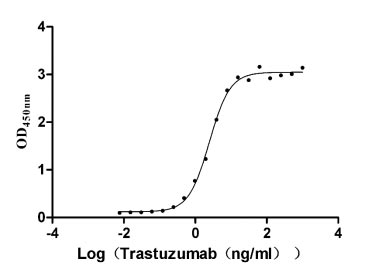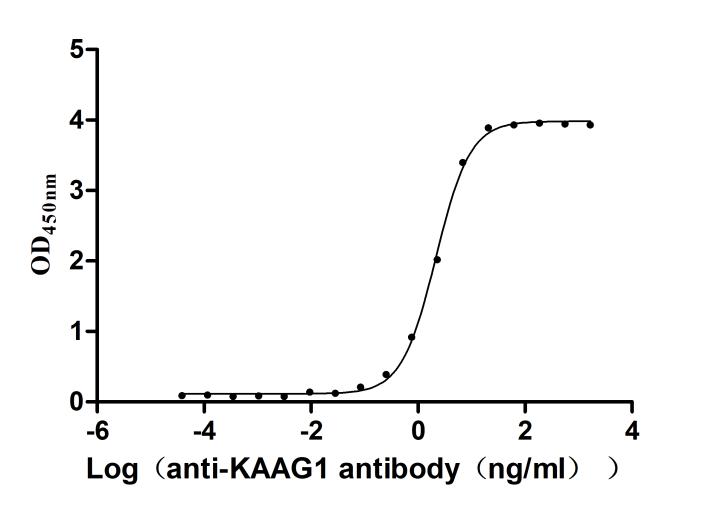Recombinant Rat Cyclic AMP-dependent transcription factor ATF-4 (Atf4)
-
货号:CSB-YP880648RA
-
规格:
-
来源:Yeast
-
其他:
-
货号:CSB-EP880648RA-B
-
规格:
-
来源:E.coli
-
共轭:Avi-tag Biotinylated
E. coli biotin ligase (BirA) is highly specific in covalently attaching biotin to the 15 amino acid AviTag peptide. This recombinant protein was biotinylated in vivo by AviTag-BirA technology, which method is BriA catalyzes amide linkage between the biotin and the specific lysine of the AviTag.
-
其他:
-
货号:CSB-BP880648RA
-
规格:
-
来源:Baculovirus
-
其他:
产品详情
-
纯度:>85% (SDS-PAGE)
-
基因名:
-
Uniprot No.:
-
别名:Atf4; Cyclic AMP-dependent transcription factor ATF-4; cAMP-dependent transcription factor ATF-4; Activating transcription factor 4; rATF-4
-
种属:Rattus norvegicus (Rat)
-
蛋白长度:full length protein
-
表达区域:1-347
-
氨基酸序列MTEMSFLNSE VLAGDLMSPF DQSGLGAEES LGLLDDYLEV AKHFKPHGFS SDKAGSSEWL AMDGLVSASD TGKEDAFSGT DWMLEKMDLK EFDFDALFRM DDLETMPDEL LATLDDTCDL FAPLVQETNK EPPQTVNPIG HLPESVIKVD QAAPFTFLQP LPCSPGFLSS TPDHSFSLEL GSEVDISEGD RKPDSAAYIT LTPQCVKEED TPSDSDSGIC MSPESYLGSP QHSPSTSRAP PDSLPSPGVP RGSRPKPYDP PGVSVTAKVK TEKLDKKLKK MEQNKTAATR YRQKKRAEQE ALTGECKELE KKNEALKEKA DSLAKEIQYL KDLIEEVRKA RGKKRVP
-
蛋白标签:Tag type will be determined during the manufacturing process.
The tag type will be determined during production process. If you have specified tag type, please tell us and we will develop the specified tag preferentially. -
产品提供形式:Lyophilized powder
Note: We will preferentially ship the format that we have in stock, however, if you have any special requirement for the format, please remark your requirement when placing the order, we will prepare according to your demand. -
复溶:We recommend that this vial be briefly centrifuged prior to opening to bring the contents to the bottom. Please reconstitute protein in deionized sterile water to a concentration of 0.1-1.0 mg/mL.We recommend to add 5-50% of glycerol (final concentration) and aliquot for long-term storage at -20℃/-80℃. Our default final concentration of glycerol is 50%. Customers could use it as reference.
-
储存条件:Store at -20°C/-80°C upon receipt, aliquoting is necessary for mutiple use. Avoid repeated freeze-thaw cycles.
-
保质期:The shelf life is related to many factors, storage state, buffer ingredients, storage temperature and the stability of the protein itself.
Generally, the shelf life of liquid form is 6 months at -20°C/-80°C. The shelf life of lyophilized form is 12 months at -20°C/-80°C. -
货期:Delivery time may differ from different purchasing way or location, please kindly consult your local distributors for specific delivery time.Note: All of our proteins are default shipped with normal blue ice packs, if you request to ship with dry ice, please communicate with us in advance and extra fees will be charged.
-
注意事项:Repeated freezing and thawing is not recommended. Store working aliquots at 4°C for up to one week.
-
Datasheet :Please contact us to get it.
相关产品
靶点详情
-
功能:Transcription factor that binds the cAMP response element (CRE) (consensus: 5'-GTGACGT[AC][AG]-3') and displays two biological functions, as regulator of metabolic and redox processes under normal cellular conditions, and as master transcription factor during integrated stress response (ISR). Binds to asymmetric CRE's as a heterodimer and to palindromic CRE's as a homodimer. Core effector of the ISR, which is required for adaptation to various stress such as endoplasmic reticulum (ER) stress, amino acid starvation, mitochondrial stress or oxidative stress. During ISR, ATF4 translation is induced via an alternative ribosome translation re-initiation mechanism in response to EIF2S1/eIF-2-alpha phosphorylation, and stress-induced ATF4 acts as a master transcription factor of stress-responsive genes in order to promote cell recovery. Promotes the transcription of genes linked to amino acid sufficiency and resistance to oxidative stress to protect cells against metabolic consequences of ER oxidation. Activates the transcription of NLRP1, possibly in concert with other factors in response to ER stress. Activates the transcription of asparagine synthetase (ASNS) in response to amino acid deprivation or ER stress. However, when associated with DDIT3/CHOP, the transcriptional activation of the ASNS gene is inhibited in response to amino acid deprivation. Together with DDIT3/CHOP, mediates programmed cell death by promoting the expression of genes involved in cellular amino acid metabolic processes, mRNA translation and the terminal unfolded protein response (terminal UPR), a cellular response that elicits programmed cell death when ER stress is prolonged and unresolved. Together with DDIT3/CHOP, activates the transcription of the IRS-regulator TRIB3 and promotes ER stress-induced neuronal cell death by regulating the expression of BBC3/PUMA in response to ER stress. May cooperate with the UPR transcriptional regulator QRICH1 to regulate ER protein homeostasis which is critical for cell viability in response to ER stress. In the absence of stress, ATF4 translation is at low levels and it is required for normal metabolic processes such as embryonic lens formation, fetal liver hematopoiesis, bone development and synaptic plasticity. Acts as a regulator of osteoblast differentiation in response to phosphorylation by RPS6KA3/RSK2: phosphorylation in osteoblasts enhances transactivation activity and promotes expression of osteoblast-specific genes and post-transcriptionally regulates the synthesis of Type I collagen, the main constituent of the bone matrix. Cooperates with FOXO1 in osteoblasts to regulate glucose homeostasis through suppression of beta-cell production and decrease in insulin production. Activates transcription of SIRT4. Regulates the circadian expression of the core clock component PER2 and the serotonin transporter SLC6A4. Binds in a circadian time-dependent manner to the cAMP response elements (CRE) in the SLC6A4 and PER2 promoters and periodically activates the transcription of these genes. Mainly acts as a transcriptional activator in cellular stress adaptation, but it can also act as a transcriptional repressor: acts as a regulator of synaptic plasticity by repressing transcription, thereby inhibiting induction and maintenance of long-term memory. Regulates synaptic functions via interaction with DISC1 in neurons, which inhibits ATF4 transcription factor activity by disrupting ATF4 dimerization and DNA-binding.
-
基因功能参考文献:
- Results find that ATF4 down-regulation in both hippocampal and cortical neuron cultures reduces protein and RNA levels of RhoGDIalpha. The study identified a new cellular pathway in which ATF4 regulates the expression of RhoGDIalpha that in turn affects Rho GTPase protein levels, and thereby, controls cellular functions as diverse as memory and cell motility. PMID: 27841340
- glucagon plus insulin increases FGF21 transcription by stimulating ATF4 expression PMID: 28188284
- Study showed that activating transcription factor 4 (ATF4) does not protect nigral DA neurons against an human alpha-synuclein -induced pathology. The recombinant adeno-associate virus -mediated overexpression of ATF4 resulted in severe nigra-striatal degeneration via activation of caspases 3/7. PMID: 27233218
- ATF-4 is involved in endoplasmic reticulum stress-mediated apoptosis contributing to vascular calcification. PMID: 23686245
- TGFbeta stimulates vimentin production via PI3K-Akt-mTOR signaling, which leads to suppression of ATF4-dependent Ocn transcription and osteoblast differentiation. PMID: 22952236
- The findings demonstrate the role of ATF-4 in both injury- and PDGF-BB-inducible tenascin-4 expression and cell migration. PMID: 22507839
- Data indicate that ATF4 has a central role in regulating xCT expression and resistance against oxidative stress. PMID: 22095285
- Only degenerating MNs presented early activation of IRE1alpha, revealed by an increase of the spliced isoform of Xbp1 and accumulation of ATF4 in their nucleus, two branches of the UPR, and late BiP downregulation. PMID: 21436843
- These behavioral and immunohistochemical findings imply that facet-mediated pain may be sustained through other pathways of the integrated stress response. PMID: 21821103
- ATF4 overexpression in nucleus accumbens decreases emotional reactivity and increases depression-like behavior. PMID: 18305237
- Findings indicate that gamma-tocopheryl quinone acts as a signal messenger to induce adaptive response through the upregulation of intracellular GSH synthesis via transcriptional activation of ATF4. PMID: 18654882
- ATF4 and phospho-eIF2alpha levels are tightly correlated and up-regulated in Alzheimer disease PMID: 19017641
- vimentin acts as a break on differentiation in immature osteoblasts by interacting with ATF4 PMID: 19726676
显示更多
收起更多
-
亚细胞定位:Nucleus. Nucleus speckle. Cytoplasm. Cell membrane. Cytoplasm, cytoskeleton, microtubule organizing center, centrosome.
-
蛋白家族:BZIP family
-
组织特异性:Expressed in brain, heart, liver, spleen, lung and muscle, but not testis.
-
数据库链接:
KEGG: rno:79255
STRING: 10116.ENSRNOP00000060302
UniGene: Rn.2423
Most popular with customers
-
Recombinant Human Receptor tyrosine-protein kinase erbB-2 (ERBB2), partial (Active)
Express system: Mammalian cell
Species: Homo sapiens (Human)
-
Recombinant Dog Angiopoietin-2 (ANGPT2) (Active)
Express system: Mammalian cell
Species: Canis lupus familiaris (Dog) (Canis familiaris)
-
Recombinant Human Epithelial discoidin domain-containing receptor 1 (DDR1), partial (Active)
Express system: Mammalian cell
Species: Homo sapiens (Human)
-
Recombinant Macaca fascicularis lymphocyte antigen 6 family member G6D (LY6G6D) (Active)
Express system: Yeast
Species: Macaca fascicularis (Crab-eating macaque) (Cynomolgus monkey)
-
Recombinant Human Interleukin-2 receptor subunit alpha (IL2RA), partial (Active)
Express system: Mammalian cell
Species: Homo sapiens (Human)
-
Recombinant Mouse CUB domain-containing protein 1 (Cdcp1), partial (Active)
Express system: Mammalian cell
Species: Mus musculus (Mouse)
-
Recombinant Macaca Gastric inhibitory polypeptide receptor(GIPR), partial (Active)
Express system: yeast
Species: Macaca fascicularis (Crab-eating macaque) (Cynomolgus monkey)
-
Recombinant Human Kidney-associated antigen 1(KAAG1) (Active)
Express system: E.coli
Species: Homo sapiens (Human)




















